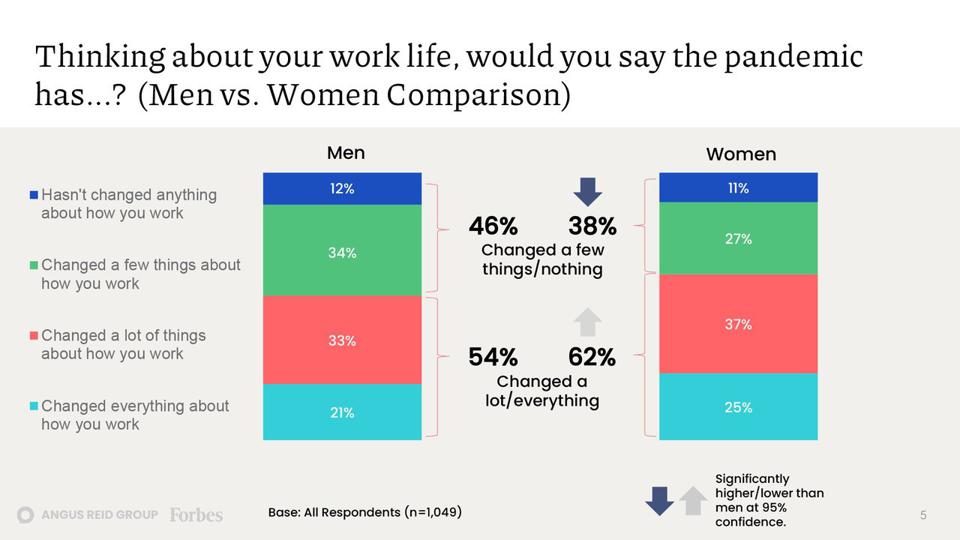
It is often said that “hope is not a strategy,” but perhaps when planning the future of work, it should be.
The COVID-19 crisis, concurrent with political strife and divisiveness, has created an unprecedented rise in fear, pessimism, and hopelessness for working women, particularly moms and women of color. I will not rehash the statistics you’ve already seen in the headlines, but on virtually every metric, women have been disproportionately affected by this crisis – so much so that the International Monetary Fund warns that nearly 30 years of economic progress for women could be wiped out by the pandemic and related worldwide recessions.
The pandemic ushered in remarkable changes to the way we work. But the public discourse has largely revolved around the role of technology and the ability to work from home, or indeed, the glamorous sounding “work from anywhere.” As I set out to better understand how working men and women felt about the state of work, both current and future, I partnered with C200 and the Angus Reid Group (ARG) to commission an exclusive poll of 1,000 American adults.
One of our most important findings was that too many discussions about the future of work are filtered through the lens of middle and upper-class, largely white, knowledge workers. In reality, working from home is only an option for some 4 in 10 Americans. Particularly for women and most notably, women of color, the vast majority have no flexibility to work from home. Their disproportionate employment in the education, healthcare, retail, and service industries offer them little flexibility.
In our survey, women were also twice as likely as their spouse/partner to take paid and unpaid time off or even drop out of the workforce to deal with growing family responsibilities.
As podcasters and company CEOs Samantha Ettus and Amy Nelson point out in a recent Newsweek editorial, even a single year of “off-ramping” can cost a woman 18% of her future earnings. They report that women who leave the workplace for an extended period have a 38% chance of never again finding full-time employment. Lacking any form of financial independence, these women are more vulnerable to abuse, both physical and emotional, as well as devastating financial impact in the event of divorce, the death or the disability of a partner.
Many employers have worked to implement policies and procedures to ease this strain. In my exploration with fellow C200 members — an organization that consists of women CEOs, entrepreneurs, and board directors — over half report making changes like improved mental healthcare benefits, significant changes to the physical workplace, and investment in collaboration technology.
But in the broader working world, the employee outlook remains gloomy.
In a Reach3 Insights/Rival Technologies survey of 500 women, only 15% thought employers were doing enough to address the work/life balance challenges employees are facing.
In our C200/ARG poll, a whopping two-thirds of participants were ambivalent or pessimistic that work life will change in a way that makes it more fulfilling for them over the next five years. Interestingly, even with the outsized effect of the pandemic on women, we found their level of optimism no different from that of men — perhaps a true testimonial to female resilience.

I was curious to learn what American working women think will improve workplaces in the future. When posed with a variety of potential employer-provided benefits, we found there was no single, silver-bullet solution. The most popular ideas were those that provided increased flexibility and agency over their lives. From 4-day work weeks, to ensuring adequate paid sick leave, to accommodating flexible start times, women want more choice in the future than they’ve had in the past.
It is important to extend this flexibility at all levels and roles, not simply to the white-collar workforce. Women in production-type jobs are amongst the most frustrated and stressed by their lack of flexibility at work. This desire for greater freedom of time was also shared by men, creating an opportunity for employers to develop future workplaces that address women’s needs while also benefiting the entire workforce.
There were a number of proposed solutions the survey participants did not find very compelling. In general, women were less enthusiastic than expected about employer-provided childcare. While most certainly want better and more affordable options for childcare, they prefer the freedom to choose the solutions that work best for them. Government or employer provided plans that help offset the cost of quality childcare appear to be better aligned with working moms’ aspirations than having employers get into the childcare business.
To build a better future workplace, now is the time to start making meaningful change. I have compiled some immediate suggestions, many of which are not particularly costly or onerous for business.
When it comes to inputs, none is more important than the voice of employees. We must go beyond simple employee satisfaction surveys and build effective employee feedback mechanisms such as employee experience communities designed to provide regular and ongoing feedback.
Another key input is measurement. “You get what you measure” may be cliché, but it is nonetheless true. Organizations like Paradigm for Parity offer an outstanding toolkit to employers striving to create a more equitable workplace. Similarly, Equileap’s Gender Equality Scorecard and rankings can become an important part of a company’s ESG initiatives.
Listening and measuring are only valuable if we do something with what we learn. There are few things more frustrating to employees than to ask their opinion and change nothing. From the listening we’ve done and building on the excellent research done by Mercer Consulting on the new shape of work, I believe employers must do more to modify their benefit programs to reflect what their employees, particularly women, people of color, and parents, genuinely value. At the top of that list? Greater flexibility, more focus on value created than “hours in the saddle,” and expanding the view of healthcare to include mental health and broader well-being.
Finally, executives must hold themselves to account and ensure that employees and employee programs are seen as investments with measurable ROI, not simply expenses to be cut. Boards should include responsible approaches to employees and communities as key aspects of the company’s ESG and social responsibility efforts, and every committee - from governance to compensation to audit - must view their responsibilities through this lens. Companies with lobbying initiatives need to be attentive to causes that will indirectly benefit the business by directly benefiting employees on key issues such as childcare, healthcare, and mental health benefits.
But ultimately, the buck stops at the CEO. The best CEOs are resilient, driven by optimism (that is also realistic), a moral compass, a set of beliefs, emotional flexibility, and social connectedness. And the very best CEOs instill these traits in their employees. Resilient CEOs and employees build resilient companies — companies that deliver sustained performance for all stakeholders, including shareholders. CEOs who embrace a strategy of building resilient workplaces of the future are the future. And that strategy gives me hope.
Note: A version of this article first appeared in Forbes.
Subscribe to our blog to receive the latest news, trends and best practices from market research experts.

No Comments Yet
Let us know what you think